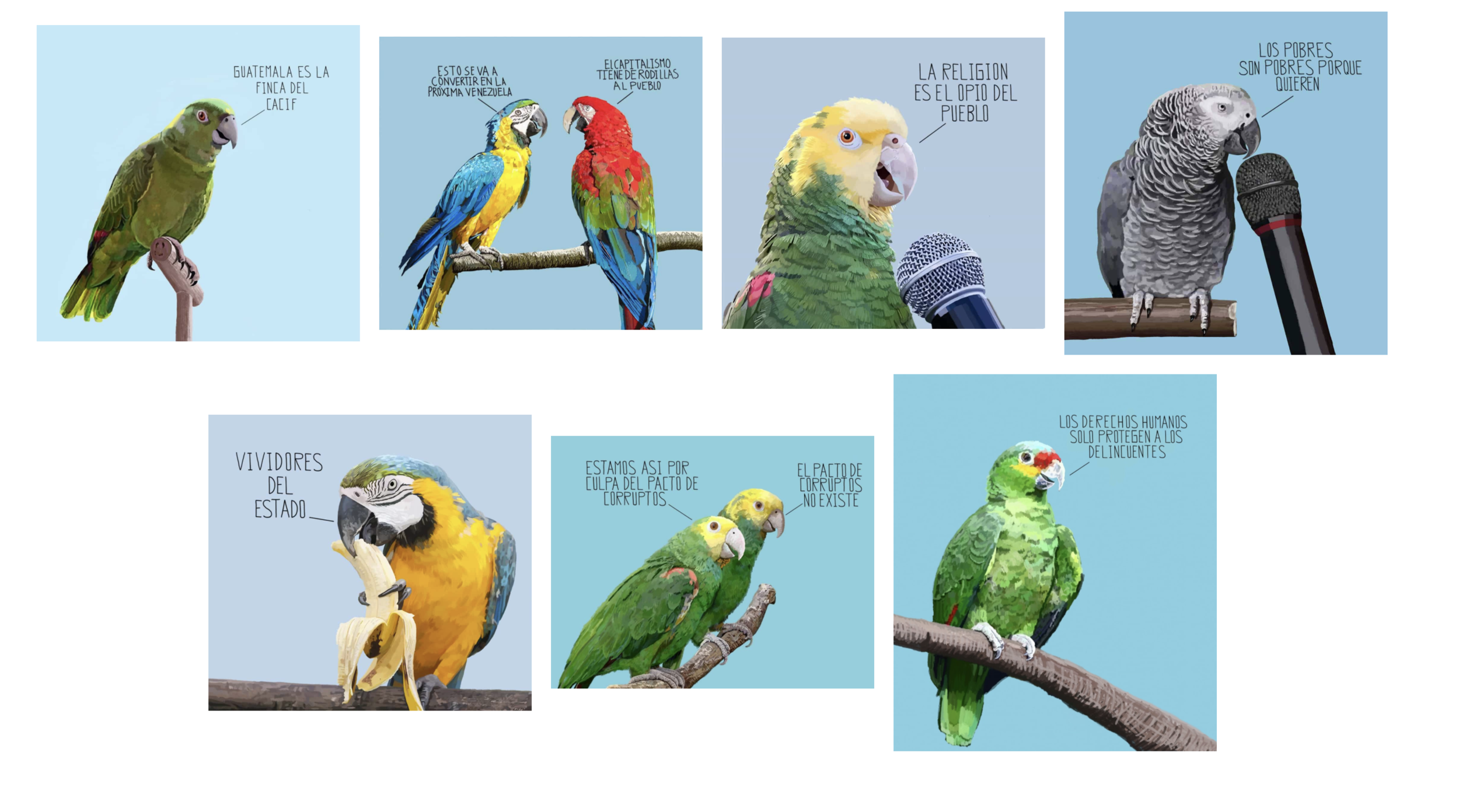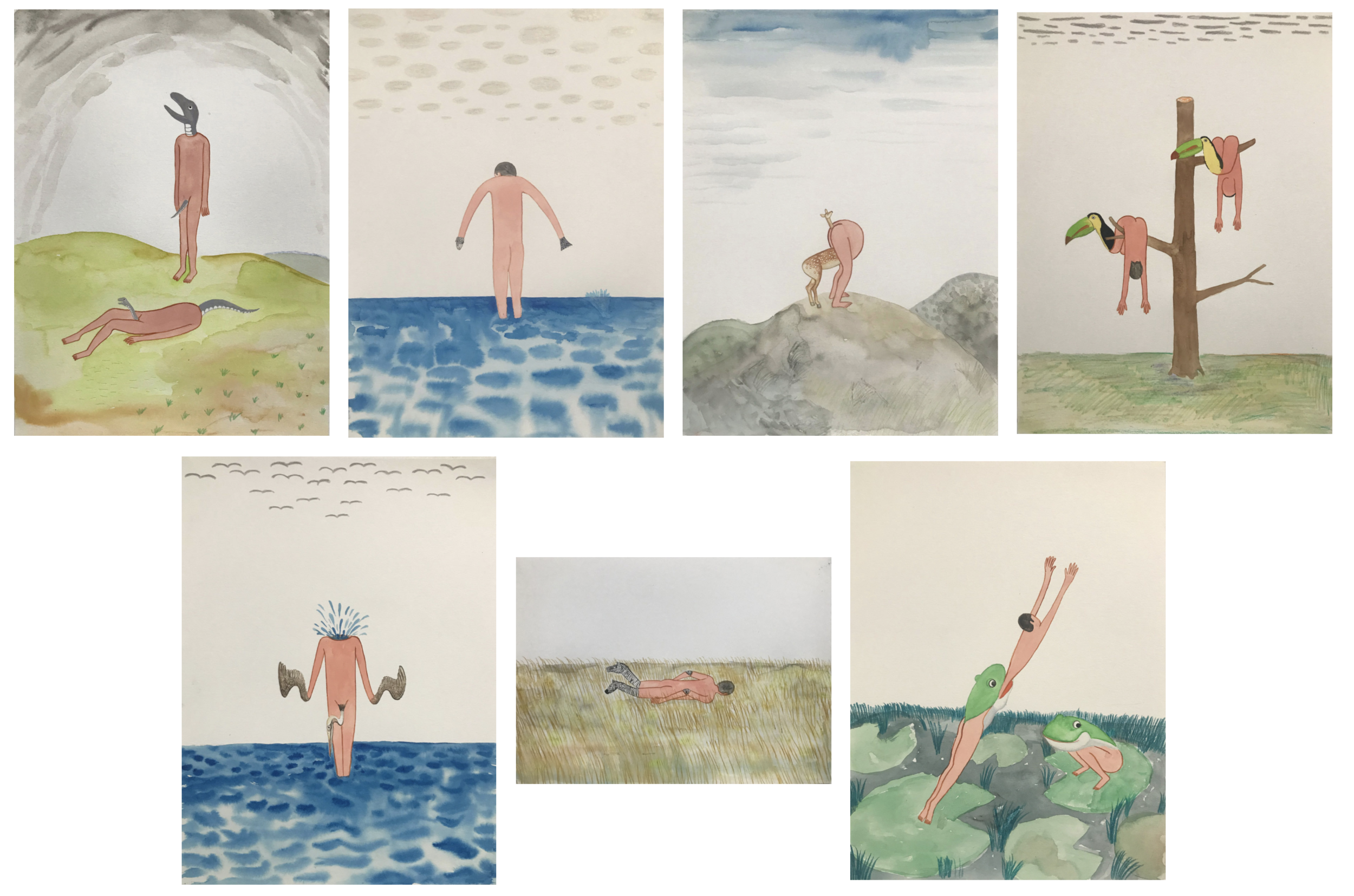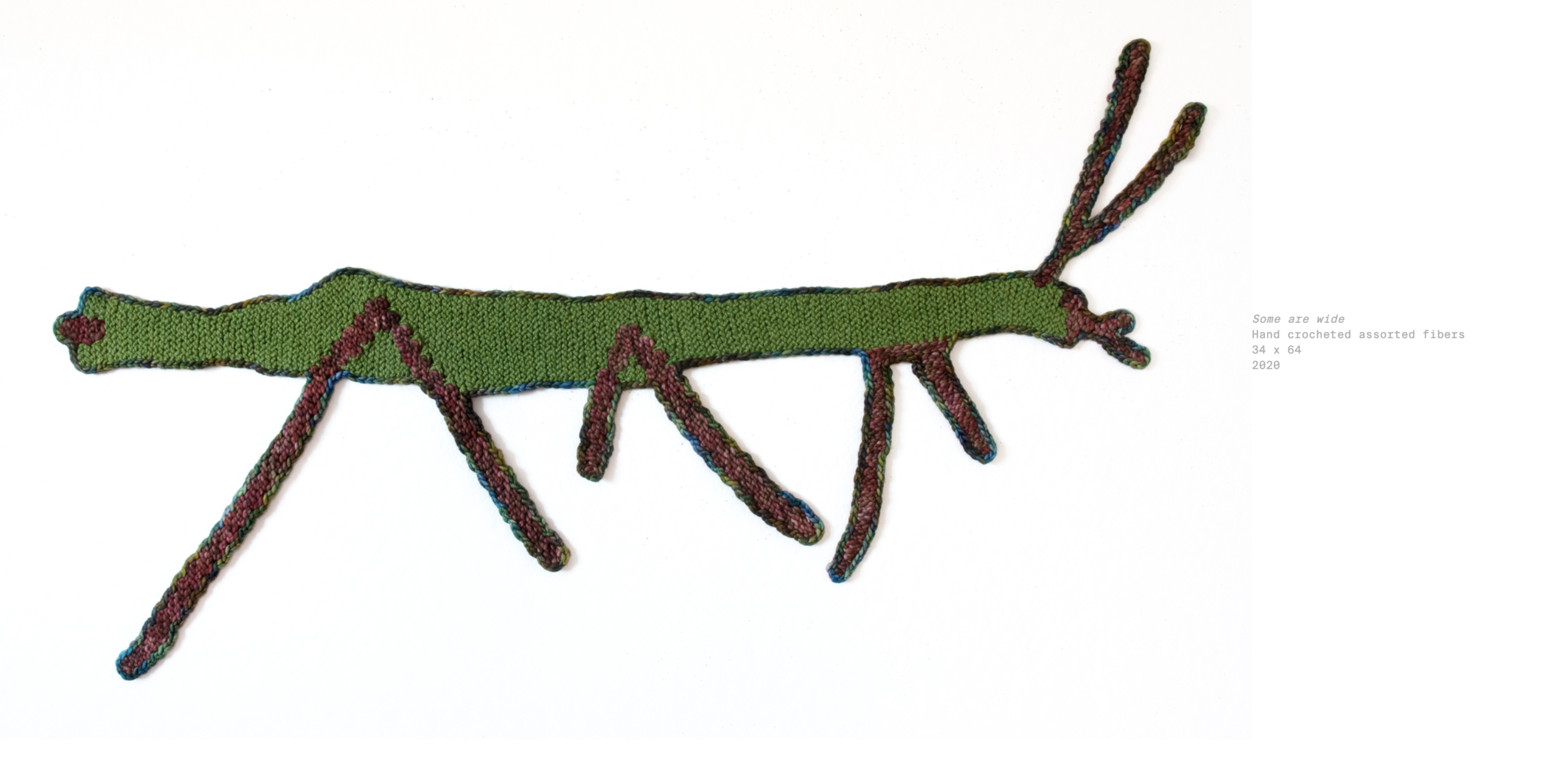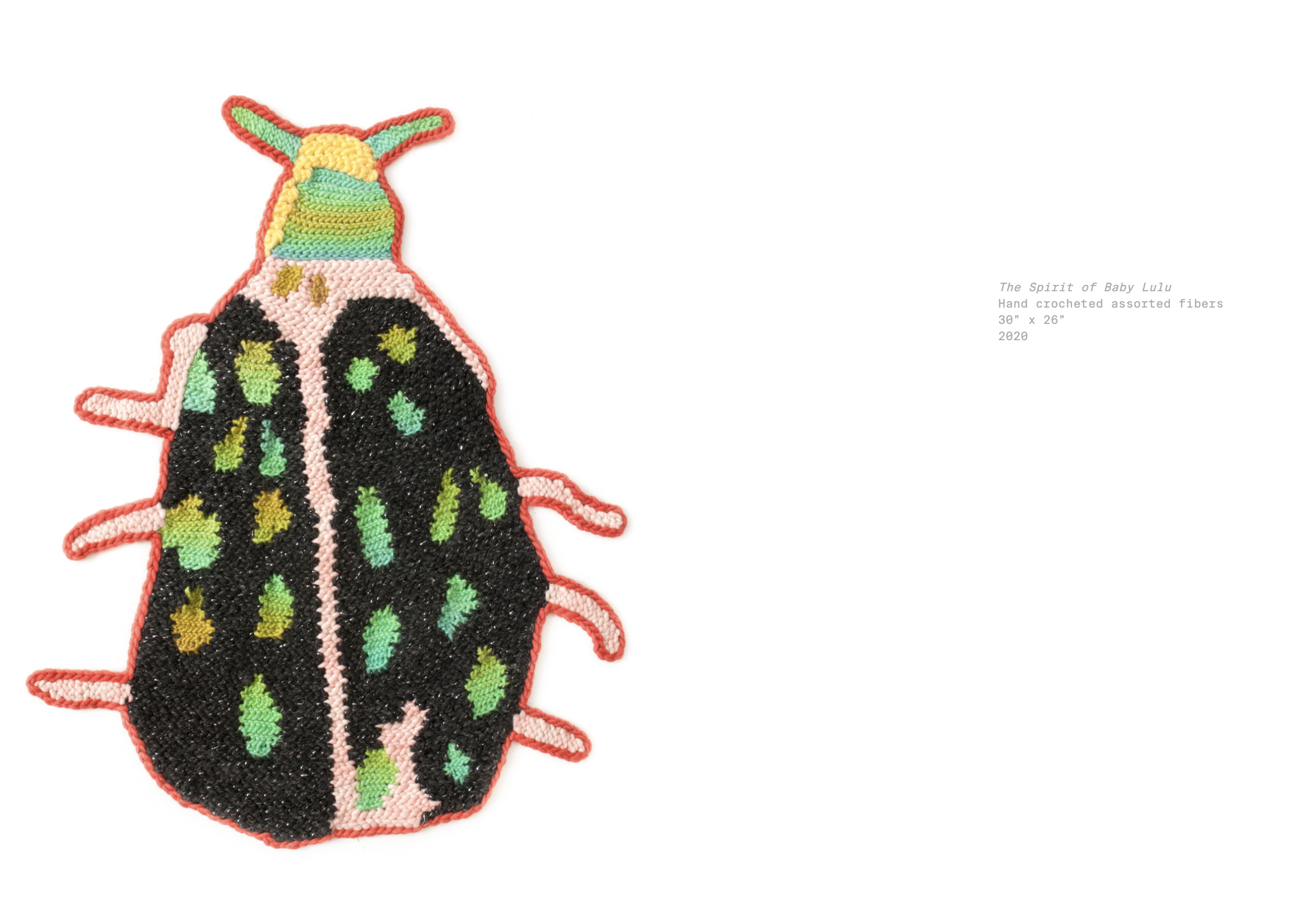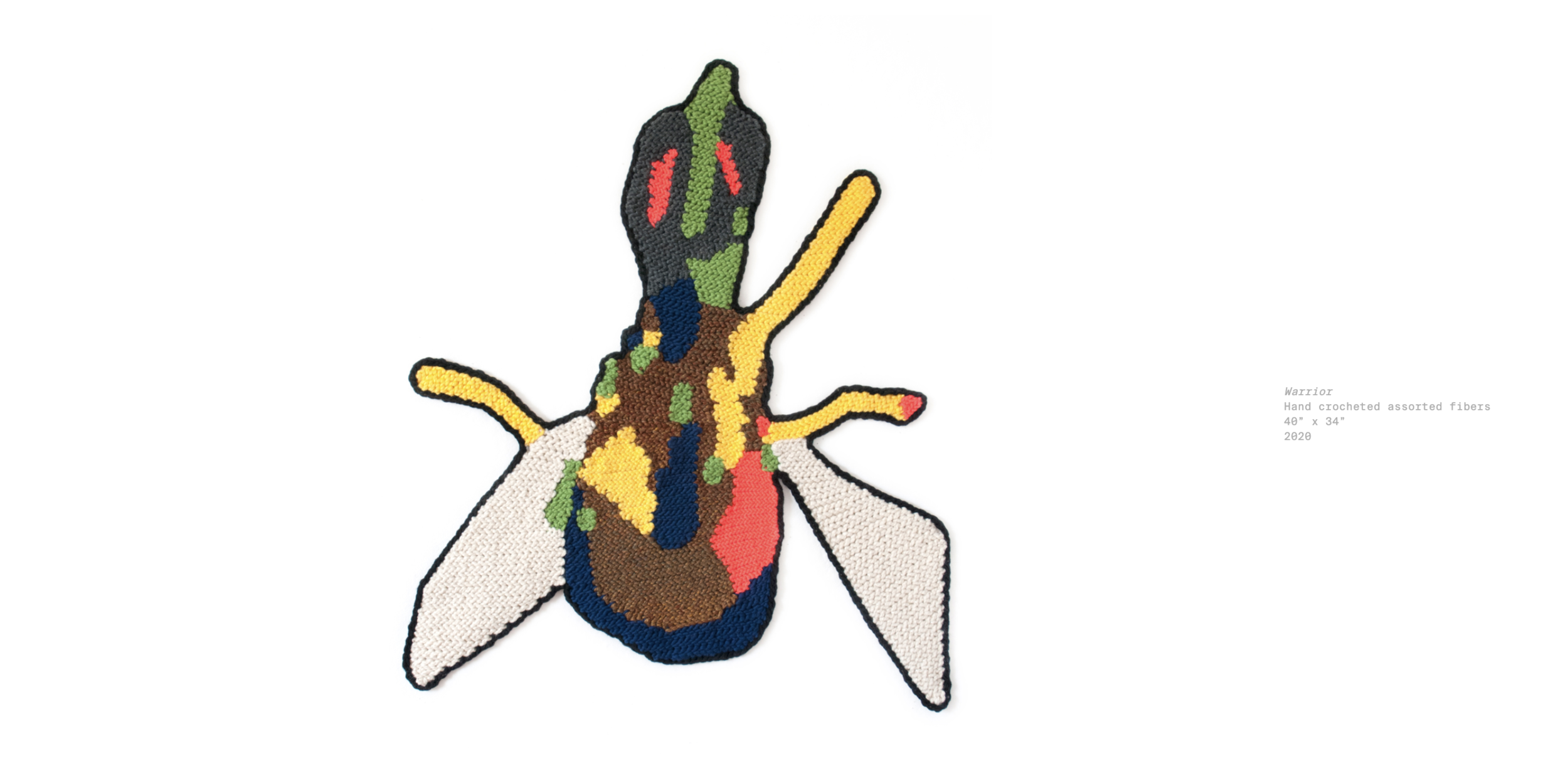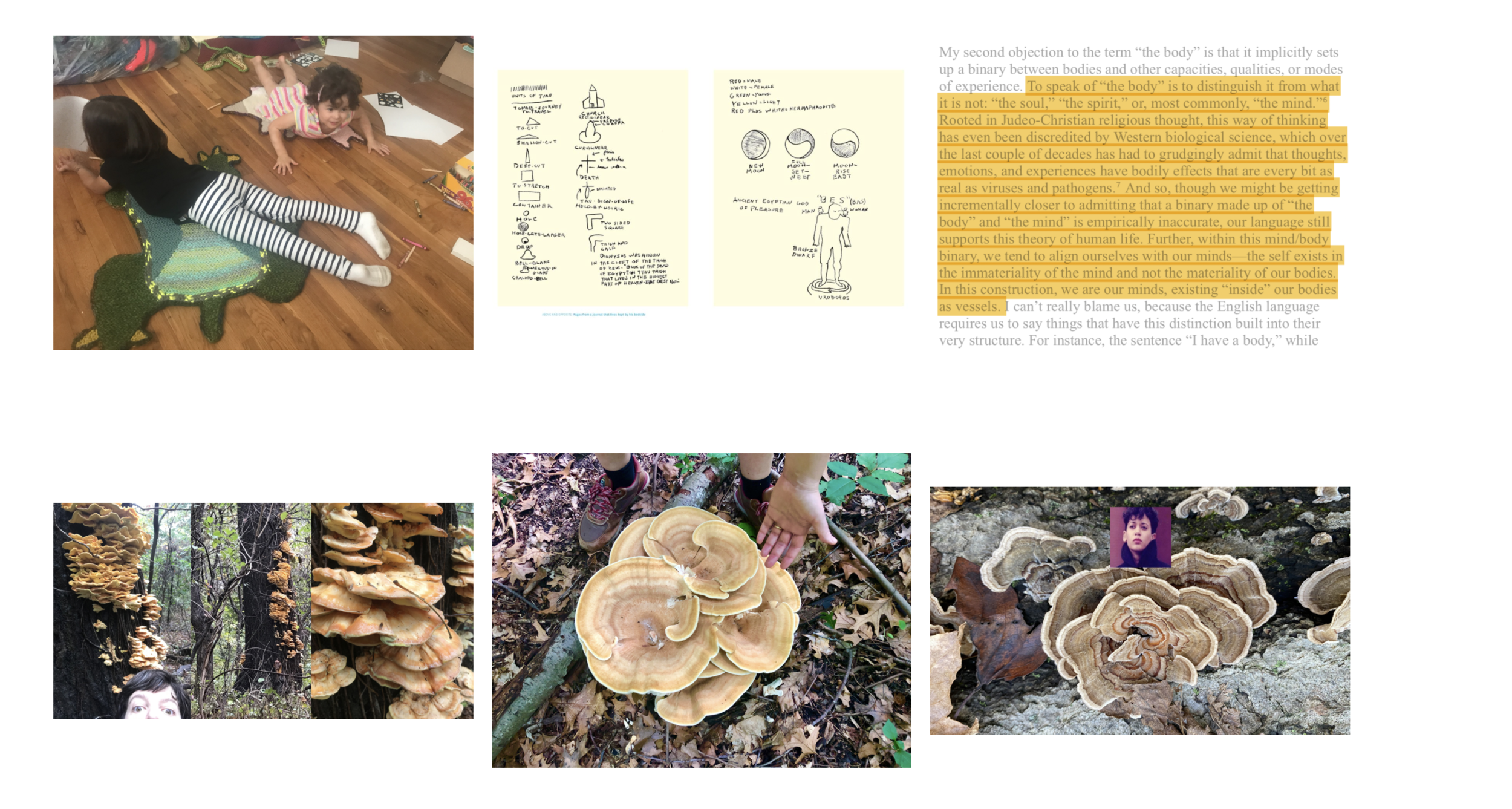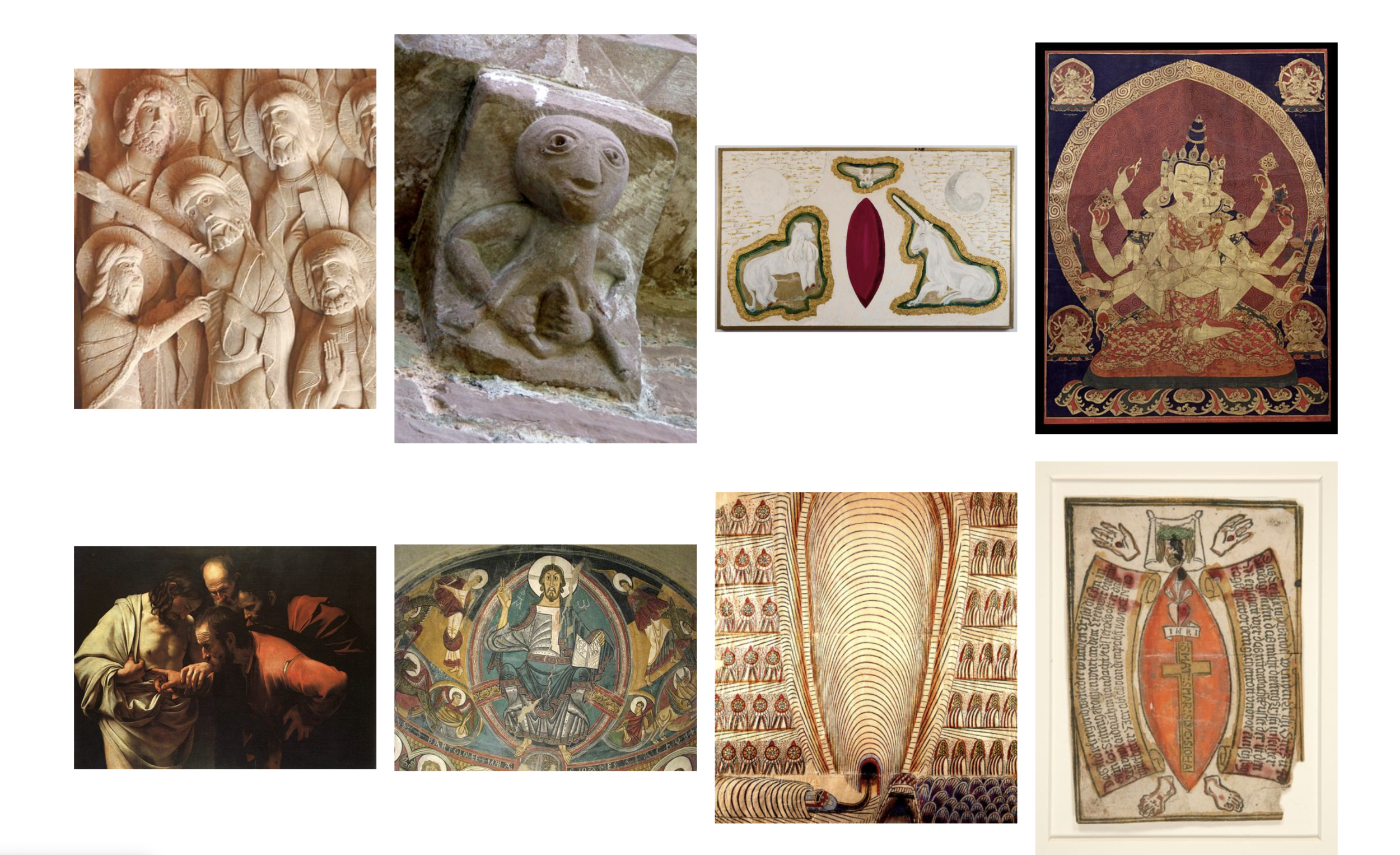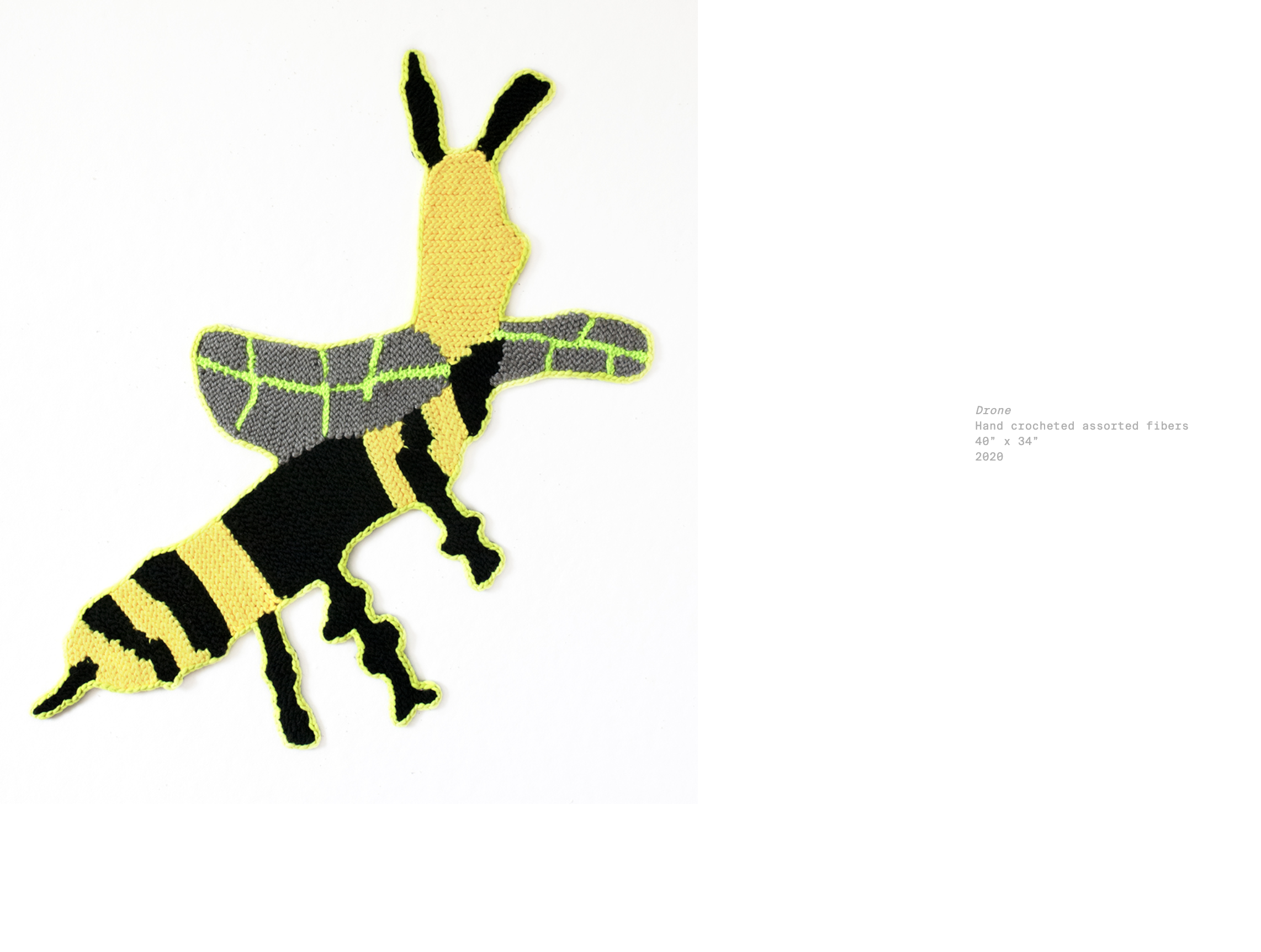On porous edges and radical decay: to soften the boundaries of things
Full project available at www.museotamayo.org/thebackroom
Working across drawing, painting, mixed-media, crochet, video animation, and collage, Caroline Wells Chandler, Akira Ikezoe, and Mario Santizo are, perhaps, only bound together by how they unbind. From Akira's taxonomic undoing of museum collections, we see a dissolve of the Western systems of knowledge that guide such "comprehensive" collections; in his idiosyncratic collecting practice and his mixed-media drawings and animations, he follows a dreamlike process, similar to the entropic overgrowth of buildings covered in mud or grass, the transmutation of human to animal, how tail becomes tale. Diagrams become stories instead of directions, coconut heads disrupt collection logics, man becomes zebra. Caroline walks the woods, doing deep observation of the restorative processes of decay that happen there. The months of quarantine in New York slow daily life down, making natural processes more visible in their fullness, more resonant in their interrelationships. He crochets bugs, a turtle, a leaf, reads nature books, returns over and over to the Christ-wound and its evocative form, a site of physical transformation/penetration and a mysterious portal. Mario might be an anti-Linnaeus of his city, cataloging the emotional paradoxes of the place, always curious about how local knowledge (including history and humor, ethics and violence) forms and perverts itself. His parrots describe the repetitive formation of a politically vacuous discourse; his revisioning of the conquest collaboratively transforms and cuirs history's textbook image. He draws the way the individual is disappeared by the city. Boundaries are an agreed-upon edge of something, but when we soften them, there is some kind of intuitive-responsive description left behind that defies simple definition. Seen together, Mario, Caroline, and Akira follow the connective tissues of the imagination as a natural site of synthesis: there, they suggest, we find worlds less bound by the logic of either/or, a shapeshifting ecosystem of stories, constellations of knowledge that make the self a collection rather than a single site. And so, maybe this is about bodies too, and how they are infinitely porous, always an accumulation of new growth and broken-down pasts, always in relationship to the worlds being born and crumbling around them.
In his series Desaparecer (To Disappear), Mario draws himself losing his bodily boundaries in the environment around him, the urban structures and ecosystems of Guatemala City. We see half a figure, his pant leg and t-shirt erased into the outline of a tree. He is not behind it, he is it. The figure crouches into a planter, an outline marking where the human was; the flowers more fully rendered. To disappear, to be disappeared, have specific resonances in the context of this place. In Mario’s imaginary, though, the self blends into the city’s surfaces, in a mushroom-like process of absorption and erasure that makes his body's edges much more porous.
In a series of digital paintings, Mario studies parrots whose political commentary is reiterative. They squawk the phrases that we hear, casually: "Religion is the opium of the masses," "People are poor because they choose to be," the birds shout, emphatically narrowing complex realities into political black-and-whiteness. "Where does our political ideology come from?" Mario asks. "Is it something that we think about, or that we build and meditate based on our research or that comes from our historical memory? Or is it just the repetition or imitation of what we hear in the social circle to which we belong or to which we want to belong?" He has often used the fissures between animal and human to illustrate emotional states, moral ambiguities, and political comedy. Two bunnies shake hands in business suits. A stag wrestles a man to the ground. "...the funny is always tripping over the not funny, sometimes appearing identical to it," write Lauren Berlant and Sianne Ngai.
In 2018, Santizo painted a series of fires on canvas, "The burning of the National Museum of Brazil made me reflect on the fragility on which history is built: everything can be lost in an accident or a premeditated act," he writes. "Guatemala has a frequent relationship to fire: the many times the market La Terminal in Zone 4 has burned, the killings at the Spanish Embassy in 1980, the recent eruption of the Volcán de Fuego that ended in tragedy… the 41 girls burned to death in the Safe House of the Virgin of the Asunción in the custody of public authorities… I wanted to at least symbolically bring fire to Correos, a building administered by the government of Guatemala. May it burn, too." Recently, Santizo installed a hand-painted theatrical backdrop in front of the Centro Cultural de España in Guatemala City. Three ships float in the impossibly blue water just behind a sandy beach, a cartoonishly happy staging of the arrival of the Spanish to conquer and colonize the Americas. The work invites silliness, even in its decolonial gesture: one person brings a banner featuring Elvis to stand in the “sand,” a group of cuir youth in leather masks, fishnets, and elaborate pastel dresses pose with anarchy banners, children hold hands and look curiously at their parents.
If the boundaries between animal and human nature are overlapping, so too, are the boundaries between memory, history, and emotion, themselves a fragile ecosystem of interactive malleability and shifting power relations. Bodies are made up of more than matter; or memories and relationships become a kind of material object. Either way, Mario suggests, the diverse manifestations of humor--even when it's an uneasy laugh--give us wiggle room, a breathing space from which to consider history's inherent shapeshifting, and our own constant state of re-learning, unknowing, influencing, change.
In one of Akira's Outside in paintings, a man lays face down in a grassy field, the hillocks of green and brown meeting the taupe sky at the mid-point of the page. His elbows are slightly bent and at their seams they have split open to reveal a black and white zebra pattern. The man kicks his legs into the air, his feet have become zebra heads, the black and white stripes spreading up his legs. In two photos from his hometown of Kochi, Japan, Akira describes human architecture engulfed by nature: covered in mud, overgrown with grasses, their functions are erased by other processes. He tells me, “Japan had a huge earthquake in 2011, and that made me think there are conflicts between culture and nature around us… but, also, I thought the same type of conflicts exist inside of human bodies.” When we blend from human to tree, when our bodies cross zebras, there is a softening of edges. “There is no clear borderline between human and nature, I think.” This softening erases firm binaries and inflexible categories of knowledge, leting the Outside in. In this softer space, things can be more than one thing, can move gently into porous ambiguities, settle into erasures and fluidities. Akira has a daily drawing practice where one image becomes the structure for the next, each spinning into surreal situations from the marks of yesterday's drawing. Narrative meaning is less significant than continuity, the tail (tale!) remaking itself in retellings (re-tailings!) that let the visual forms lead the story.
Recently, Akira has been making his own taxonomy of museum collections; he takes screen-captures of the entire online collection of MoMA, and then files each image into his own system of folders, erasing the organization of the museum's canonizing logic. In Akira’s taxonomy, the categories are arranged by what he sees in the work: In his Nature folder, subfolder Animals, he includes fish and sea creatures, crocodiles, frogs, other insects, death, donkeys, animals rebelling. It’s an ambitious re-cataloging, a project that will take years. From this taxonomy, he makes a series of Coconut Head paintings: here, his iconic Coconut Heads interrupt, intertwine, penetrate works of art from various museums. Akira provides PDF documents, the catalog of images for each painting's expansive field of references. In this taxonomy, the museum's meaning-making function peels away, and the collection becomes a site of other imaginings. These wildly irreverent and curious intrusions into art history nudge the originals into compromises with Akira's universe of silliness, a flow chart storytelling that is as much exquisite corpse as sleepy bedtime story for a child reluctant to sleep, one tale/tail/telltale leading intuitively into another and another. The boundaries blur. Reversing the logic of the taxonomy project, Akira makes a series of paintings from diagrams and flow charts: his schematic source materials include drawings for three kinds of power plants, the educational system in Vietnam, stock market predictions, a weather monitoring system, a corporate workflow. The geometry of the diagrams, stripped of information, become the directives for a series of Coconut Heads misadventures. "My stories are like domino effects," he says. One thing happens and then everything else falls in a reactive sequence, guided only by the preexisting arrows and boxes. In Akira's parallel universe, one system of logic is the twin of the seemingly illogical; instructions for systems become paths to fairytales, and isn't that a generous softening to how the world "works."
“This is the first year in a long time that I’ve been able to watch the seasons changing,” Caroline (CW) observes. In quarantine, life has slowed enough to allow for daily walks at Van Cortlandt Park, where he traces the ecosystems he finds in the urban woods. “The main shift in the work, and I never thought I would say this, is I’m making nature art,” they tell me, his crocheted insects with all their legs and squiggles and wings and zips. The Spirit of Baby Lulu is a pear-shaped bug with splotches of green and yellow across its dark wings. A yellow splash of almost-hair sits between its antennae and a pink zip runs down the center of its back. Six legs ringed in orangey pink poke, point, curl, curve, protrude. We talk for a very long time about mushrooms, his recent fascination. “How can I incorporate a mushroom consciousness in the work, and in the teaching,” they wonder. This is something about fostering symbiotic connections, invisible networks of matter that help to break things down, to purify and cleanse, to take care of things. “Maybe you can be a mushroom!” they exclaim, as we talk about what curating can do in the pandemic world.
Caroline sends me photographs and illustrations of the woods from nature books; their whimsical titles--A Potpourri of Leaves, Agents of Decay, The Forest Dwellers--implying all the drama and agency of natural processes. He carries a notebook with him, making his own leaf studies that span across the bound pages. Leather Daddy from the Schitzophyllum Commune is a blue blob with little orange legs, baby blanket yellow patches on its lower back, and a phallic tongue-head up top, all bound by a speckled brown harness. They cite Gordon Hall's essay, "Why I Don't Talk about 'The Body': A Polemic": "thoughts, emotions, and experiences have bodily effects that are every bit as real as viruses and pathogens," Hall writes. Things are a little more Wavy Gravy than taxonomic, it seems, and CW's nieces pull these crochet bugs off the wall, smooshing and rolling atop them, casting their bodies into the shapes of the work: toddlers can shapeshift so quickly, so why do we hold too tightly to the parameters of our own bodies, communities, and places once we're adults? Once we see our boundaries dissolve, we enter into a much larger ecosystem, biology is starting to realize; images in dissolution become fungible, and maybe we all should be (will be) mushrooms. Together, we look at images of wounds. The punctured body, its Christian symbolism overlapping with its bodily implications of transition, transformation, permeability disrupting exhausted binaries. We talk about Forrest Bess and St. Thomas sticking his fingers under Christ's ruptured skin. We both spend time on Zillow looking at houses, imagining ourselves into other spaces: look at this woven L.L. Bean wound on the floor of my woodsy cabin dream house and tell me about how I imagine other futures. It turns out, trees and fungi are in cahoots, making partnerships called mycorrhizas. "As I knelt beneath that whitebark pine, staring at its root tips, it occurred to me that my whole life I had never really understood what a tree was. At best I'd been aware of just one half of a creature that appeared to be self-contained but was in fact legion--a chimera of bewildering proportions," writes Ferris Jabr. We are in these infinitely complex interrelationships, even in a culture that prizes the individual above all else. Be Here Now, says CW's spiral-shelled tortoise, legs akimbo, as if inviting us into much a richer soil, thick with radical connection, symbiosis in multiplicity, growth in decay.



